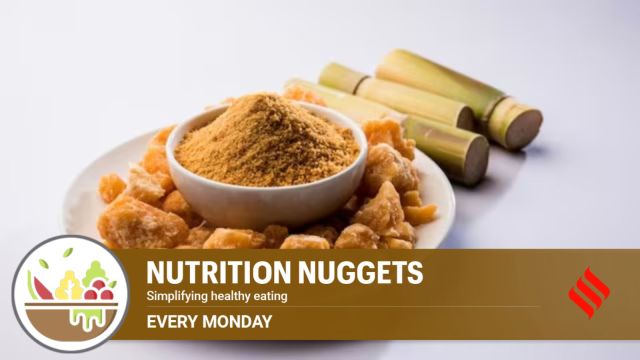How much jaggery is safe for you to have every day?
While jaggery has nutritional benefits, its primary component is still sugar, which raises concerns
 While refined sugar is pure sucrose, jaggery contains trace minerals such as iron, magnesium, potassium, and calcium, thanks to minimal processing. (File)
While refined sugar is pure sucrose, jaggery contains trace minerals such as iron, magnesium, potassium, and calcium, thanks to minimal processing. (File)Jaggery, a traditional sweetener derived from sugarcane or palm sap, is a beloved ingredient in many cultures, especially in South Asia. Known for its earthy sweetness, it is often combined with nuts and spices to create wholesome treats such as chikki or laddu.
While jaggery boasts certain nutritional benefits, its primary component is still sugar, which raises concerns about its consumption, particularly for diabetics and individuals monitoring their sugar intake. How do we then optimise its nutritional properties without raising our sugar levels?
How does jaggery differ from sugar?
That has to do with processing and nutrient retention. While refined sugar is pure sucrose, jaggery contains trace minerals such as iron, magnesium, potassium, and calcium, thanks to minimal processing. It is also rich in antioxidants and has a lower glycemic index (which measures how quickly a carbohydrate-containing food raises blood sugar levels) of 55 than refined sugar, which is at 65. One tablespoon (20 grams) of jaggery provides approximately 65-70 kcal, 15-16 gram sugar, 11 per cent of the daily recommended intake (RDI) for iron and four per cent of RDI for magnesium.
How combination with nuts helps
Nuts, like almonds, cashews and peanuts, are rich in healthy fats, protein and fibre, which slow down sugar absorption and prevent blood sugar spikes. Spices like cardamom, cinnamon and fennel not only enhance flavour but also offer anti-inflammatory and blood sugar-regulating properties. For example, chikki or jaggery-peanut brittle provides protein and unsaturated fats, which help balance the carbohydrate content of jaggery.
Try Til ke Laddu or sesame-jaggery balls. Sesame seeds add calcium, iron and magnesium to the mix, complementing jaggery’s nutrient profile. Adding ginger or cinnamon to jaggery-sweetened tea enhances its antioxidant and digestive benefits.
However, portion control remains key
The WHO recommends that added sugars should be no more than 5 per cent of your daily calorie intake. For a 2,000-calorie diet, this translates to 25–50 grams of sugar daily, including jaggery and other sweeteners. Non diabetics can include 10–15 grams (approximately 1 tablespoon) in their daily diet. For instance, enjoy a small piece of jaggery-nut brittle mid-morning and another post-lunch.
Diabetics can have 5–10 grams per day only when paired with protein or fibre.
Time It Right
Consuming jaggery in the morning or as part of a post-lunch snack aligns with higher metabolic activity, allowing for better sugar use. Monitor total sugar intake by factoring in jaggery used in teas, desserts, and savory dishes.
(Narang is nutritionist, Indraprastha Apollo Hospitals, New Delhi)






- 01
- 02
- 03
- 04
- 05

























